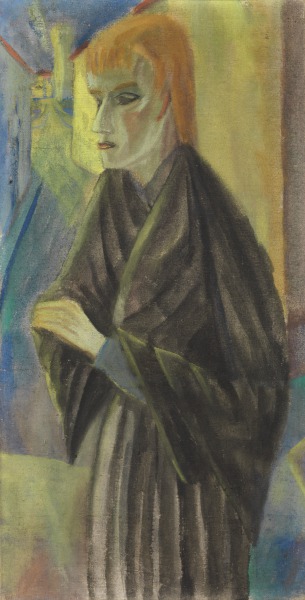
The Blind Girl (Translation)
Die Blinde (Primary Title)
Erich Heckel, German, 1883 - 1970 (Artist)
One of the original founders of Die Brücke, Heckel volunteered for military service at the outbreak of World War I in 1914, a year after the group officially broke up. The Blind Girl suggests sympathy for the vulnerability of the individual subject portrayed. Viewed in the context of the war’s complete devastation, however, it also provides a sense of cultural helplessness as Europe moved forward without any clear sense of what the future would look like when—or even if—the war ended.
The Ludwig and Rosy Fischer Collection, Gift of the Estate of Anne R. Fischer
"Expressionismus und Exil: Die Sammlung Ludwig und Rosy Fischer, Frankfurt am Main", Frankfurt: Jewish Museum, Aug. 29 - Oct. 28, 1990, no. 45, LS 125.
"German Expressionist Art: Selections from the Ludwig and Rosy Fischer Collection", Richmond: Virginia Museum of Fine Arts, Jan. 12 - Mar. 8, 1987, no. 91.
"German Expressionist Art: Selections from the Ludwig and Rosy Fischer Collection", Richmond: Virginia Museum of Fine Arts, Jan. 12 - Mar. 8, 1987, no. 91.
By 1922, Ludwig Fischer [1860-1922] and Rosy Fischer [1869-1926], Frankfurt am Main, Germany; [1] By 1926, Ernst Fischer [1896-1981] and Anne Fischer [1902-2008], Frankfurt am Main, Germany, by inheritance; [2] May 2009, Virginia Museum of Fine Arts (VMFA), Richmond, by bequest of Anne R. Fischer, 2009. [3]
[1] Ludwig and Rosy Fischer were art collectors in Frankfurt, Germany, who primarily collected contemporary German art between 1905 and 1925. Ludwig Fischer died on April 25, 1922. The Fischers acquired many of their works from the Ludwig Schames Gallery. Heckel showed in 1917, 1919, and 1921 at Schames; however, due to lack of illustrations in the sales catalogues, and generalized titles, it is difficult to determine an exact date of acquisition.
Rosy died on February 27, 1926, while traveling in North Africa. (See Brandt, Fredrick R. German Expressionist Art: Ludwig and Rosy Fischer Collection, Richmond, Virginia: Virginia Museum of Fine Arts, 1987, pp. 1 - 11).
[2] In 1926, the Fischer collection was divided equally between Ludwig and Rosy Fischer's sons, Max Fischer (1893-1954) and Ernst Fischer (1896 – 1981). In 1934, Ernst and Anne Fischer fled Germany to the United States with their part of the collection, first to Rochester, New York and then settled in Richmond, Virginia. (See Brandt, 1987, pp. 1 -11.)
[3] Information in VMFA Curatorial and Registration files.
[1] Ludwig and Rosy Fischer were art collectors in Frankfurt, Germany, who primarily collected contemporary German art between 1905 and 1925. Ludwig Fischer died on April 25, 1922. The Fischers acquired many of their works from the Ludwig Schames Gallery. Heckel showed in 1917, 1919, and 1921 at Schames; however, due to lack of illustrations in the sales catalogues, and generalized titles, it is difficult to determine an exact date of acquisition.
Rosy died on February 27, 1926, while traveling in North Africa. (See Brandt, Fredrick R. German Expressionist Art: Ludwig and Rosy Fischer Collection, Richmond, Virginia: Virginia Museum of Fine Arts, 1987, pp. 1 - 11).
[2] In 1926, the Fischer collection was divided equally between Ludwig and Rosy Fischer's sons, Max Fischer (1893-1954) and Ernst Fischer (1896 – 1981). In 1934, Ernst and Anne Fischer fled Germany to the United States with their part of the collection, first to Rochester, New York and then settled in Richmond, Virginia. (See Brandt, 1987, pp. 1 -11.)
[3] Information in VMFA Curatorial and Registration files.
©artist or artist’s estate
Some object records are not complete and do not reflect VMFA's full and current knowledge. VMFA makes routine updates as records are reviewed and enhanced.

